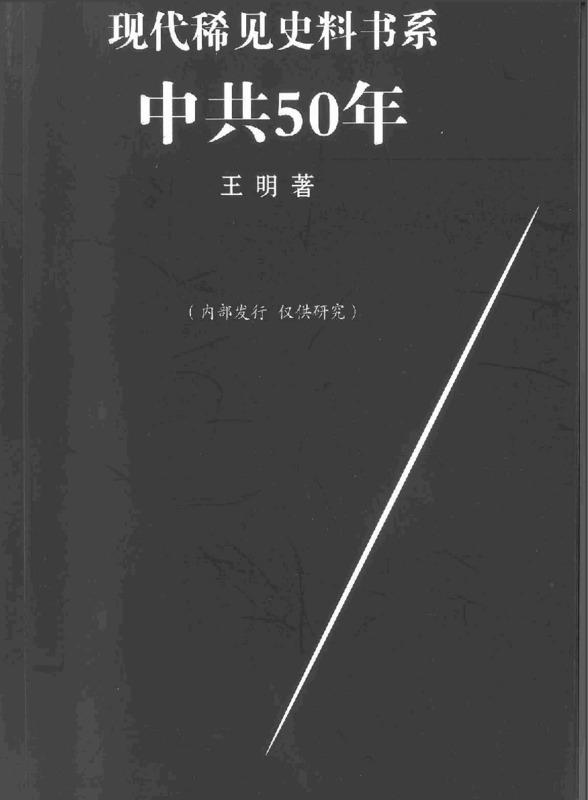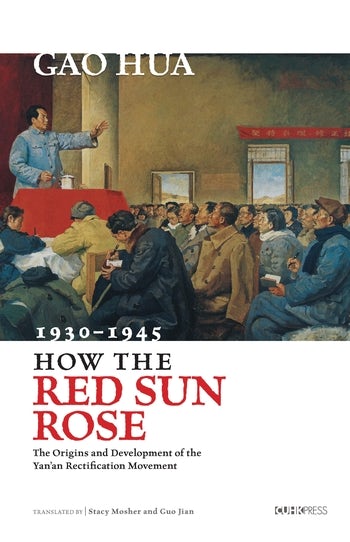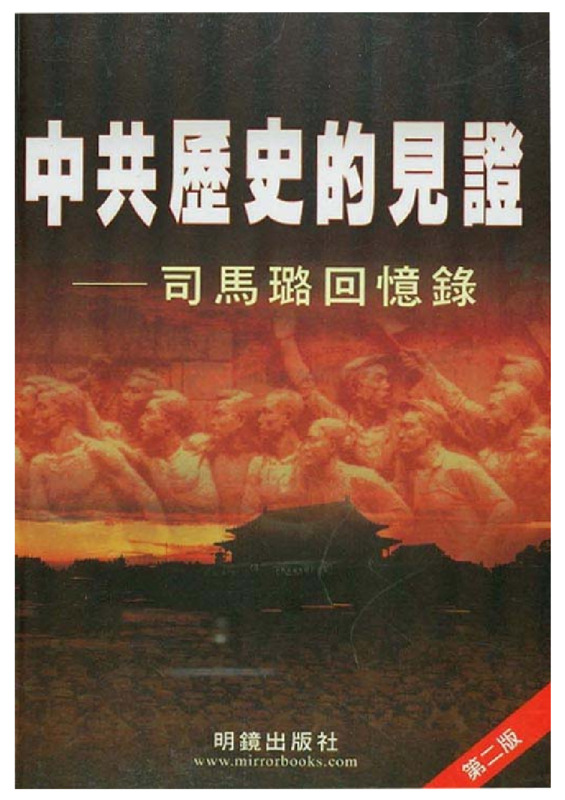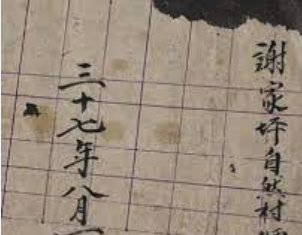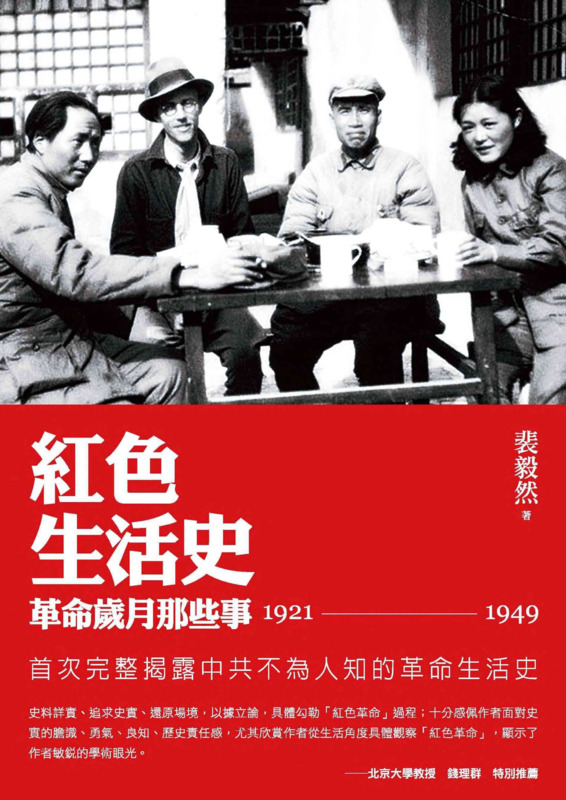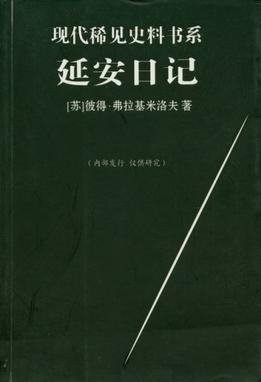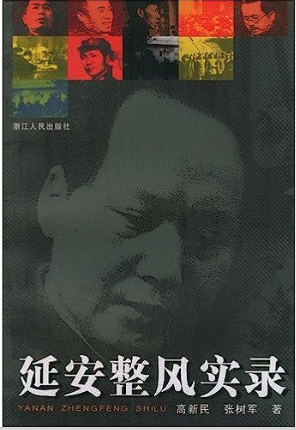Explore the collection
Showing 9 items in the collection
9 items
Book
At the Crossroads of History
This book is Gao Hua's next masterpiece after *How the Red Sun Rose*. It entails a selection of papers published by the author between 1988 and 2004, covering the fields of Republican history, Communist Party history, and contemporary Chinese history. It captures the historical interaction between the present and the past. Gao reflects deeply on the far-reaching Chinese Communist Revolution. With a rigorous and empirical research methodology, he sketches a complex and colorful picture of history, presenting the multiple facets of twentieth-century China's history.
Book
Fifty Years of the Chinese Communist Party
The author Wang Ming was an early member of the Communist Party of China (CCP) and the first of the "28 and a half Bolsheviks," who lost power after the Yan'an Rectification and were gradually marginalized by Mao. After the Yan'an Rectification, the Internationalists, led by him, lost power in the party. He was gradually ostracized by Mao Zedong, who expatriated him to the Soviet Union in 1956. In his book, Wang Ming recounts his decades-long feud with Mao. It provides a fascinating insight into the early history of the CCP.
Book
How the Red Sun Rose
Originally published in Hong Kong in Chinese in 2000, Gao Hua’s epic description of an early Communist Party campaign against dissent describes a pattern of thought reform and control that would hold true for decades to come. Written despite official harassment and Gao’s failing health, How the Red Sun Rose is a touchstone for China’s unofficial history movement. It was translated into English in 2019 and published by Columbia University Press. Purchase here: https://cup.columbia.edu/book/how-the-red-sun-rose/9789629968229.
Book
Memoirs of Sima Lu: A Witness to the History of the Chinese Communist Party, The
Sima Lu (1919-2021) was an expert on the history of the Chinese Communist Party. He joined the Chinese Communist Party in 1937, then was politically persecuted in Yan'an, left it, and was expelled from the Party in 1941. In 1952, Sima Lu published “Eighteen Years of Struggle” in Hong Kong, writing about his tortuous journey from defecting to the Communist Party to his awakening and eventual choice of freedom. It became a sensation. He has made in-depth special studies on several leading figures of the CCP, such as Qu Qubai and Zhang Guotao. His memoir, “Witness to the History of the CCP”, is divided into three chapters according to its contents: the first is about his personal experience, the second about the first generation of CCP figures, and the third is devoted to the struggle between Mao Zedong and Zhou Enlai.
Article
Poppies under the Red Sun: The Opium Trade and the Yan'an Model
In the 1990s, history scholar Chen Yongfa made a fundamental study of the opium economy two decades before the founding of the CCP and completed a monograph, "Poppies under the Red Sun: The Opium Trade and the Yan'an Model". Since then, more and more research articles have been written on the subject, and new information has appeared. Subsequently, the phenomenon of the opium economy of the CCP's Yan'an regime has also became an important field of study.
Book
Red Life History - The Revolutionary Years (1921-1949)
Professor Pei Yiran's book is the first complete revelation of the untold revolutionary history of the CCP. The book covers many important points in the history of the CCP, including the use of Soviet rubles to build the party, the landlords fundraising campaign, and the love life of Mao Zedong and Jiang Qing, among subjects.
Book
The Vladimirov Diaries: Yenan, China 1942~1945
The author of The Vladimirov Diaries: Yenan, China, 1942~1945, Peter Vladimirov (Sun Ping in Chinese) was a Soviet citizen. The book was first published in the 1980s by Oriental Publishing House and reprinted in March 2004. Peter traveled to Yan'an from 1942 to 1945 as a liaison officer of the Comintern and a correspondent for the TASS news agency. He kept a diary of the political, economic and cultural aspects of Yan'an, including its opium economy. Against the background of the relationship between the CCP and the Soviet Union during the War of Resistance against Japanese Aggression, the book describes the CCP's Rectification Movement and the Seventh National Congress. It also comments on the CCP's contact with the U.S. Military Observer Group stationed in Yan'an at the time and on the relationship between the CCP and the Kuomintang.
Book
Yan'an Rectification
The Rectification Movement took place in Yan'an, North Shaanxi Province, in the 1940s. This book, written by scholars within the Chinese official system, attempts to chronicle the ins and outs of the Rectification Movement in Yan'an and the base areas, analyzing its causes and the logical development of its results. It is rich in information that is only found here. This book was published by Zhejiang People's Publishing House in 1999.
图书
Tangni Kütüp/Awaiting for the Dawn
(English follows) “Tangni Kütüp” namliq bu eslime épik dastan uslubida, yeni she’iriy shekilde yézilghan eser bolup, 1930-yillardin 1980-yillarghiche bolghan Sherqiy Türkistan (Xinjiang)ning siyasiy we ijtima’iy tarixini xelq éytimidin chüshinishte muhim ehmiyetke igidur.
Aptor Abduqadir Zununi Uyghurlarning 20-esirdiki siyasiy we ijtima’iy hayatida yüz bergen zor weqelerge shahit bolghan, shundaqla shu jeryandiki nurghun ishlarni öz béshidin ötküzgen shexstur. U 1940-yillardin bashlap Sherqiy Türkistanda neshir qilin’ghan Uyghur tilidiki asasliq gézitlerning tehriratida tehrir we bash muherrir bolup ishligen. Yene bir tereptin edebiy ijadiyet bilen shoghullinip, Uyghurlar hayatida yüz bergen zor ijtima’iy özgirishler we siyasiy heriketlerni yéqindin közetken.
Bu eslime bir tarixiy shahitning közidin Sherqiy Türkistanning yérim esirlik siyasiy we ijtima’iy hayatini hökümet meydanidin emes, belki shu tarixni yaratquchi awam xelqning éytimidin bayan qilip bergen. Mezkur eslime aptor tughulghan 1919-yilidin bashlap, tarixiy xironologiyelik tertip boyiche 1920-yillardiki Sherqiy Türkistanning jem’iyet ehwali, 1930-yillarning bashlirida yüz bergen Sherqiy Türkistan inqilabi we Uyghurlarning milliy musteqilliq heriketliri, Xitay militarist Shéng Shiseyning 1930-yillarning ikkinchi yérimidin bashlap élip barghan qanliq qirghinchiliqi, 1944-yili partlighan Ili inqilabi we uning netijiside qurulghan Sherqiy Türkistan Jumhuriyiti, Aptorning 1940-yillarning ikkinchi yérimida Chöchekte “Xelq Awazi” gézitide ishligen mezgildiki kechürmishliri tepsiliy bayan qilin’ghan. Eslimining kéyinki bölikide 1949-yilining axiri Xitay Xelq Azadliq Armiyesining Sherqiy Türkistan’gha bésip kirishi, Ilidiki Sherqiy Türkistan Jumhuriyitining emeldin qélishi we Milliy Armiyening Xitay Xelq Azadliq Armiyesining 5-korpusi qilip özgertilishi, Kommunist Xitay bilen Sowét ittipaqining 1950-yillarning bashliridiki Sherqiy Türkistanni sehne qilghan “shirin’ay munasiwiti” qatarliq témilar bir shahitning közidin bayan qilin’ghan.
Bu eslimidiki eng muhim mezmunlarning biri, aptorning Kommunist Xitay ishghalidin kéyin, yeni 1949-yilidin 1955-yilighiche bolghan ariliqtiki körgen we bilgenliridur. Aptor bir kespiy jurnalist, shair we közetküchi bolush salahiyiti bilen öz eslimiside Kommunist Xitay ishghalidin kéyinki Sherqiy Türkistanning künsayin nacharlashqan siyasiy weziyiti we mustebit tüzümning Uyghur xelqining siyasiy arzulirini qandaq qilip birmu-bir köpükke aylandurghanliqini inchikilik bilen teswirligen. Bolupmu sabiq Sherqiy Türkistan Jumhuriyiti (1944-1949) ning hayat serxilliri bilen Uyghur xelqining Kommunist Xitay hakimiyitige qoshulushtiki eng töwen sherti – Sowét Ittipaqi modélidiki Sherqiy Türkistan/Uyghuristan Ittipaqdash Jumhuriyiti qurush – telipining qandaq qilip ret qilin’ghanliqi, uning ornigha Xitayche uslubtiki atalmish milliy téritoriyelik aptonomiye – “Shinjang Uyghur Aptonom Rayoni”ning ustiliq bilen dessitilgenliki, shundaqla uning saxta mahiyiti inchike détallar bilen körsitilgen. Aptor bu eslimiside Xitay Kompartiyesining Xitay tarixidiki féwdalliq sulalilerning chégra xelqlirini “bölüp bashqurush” taktikisidin ustiliq bilen paydillanghanliqi, aldi bilen pütkül Xitay téritoriyesining altidin bir qismini teshkil qilidighan Sherqiy Türkistanni Qazaq, Mongghol, Qirghiz, Tunggan qatarliq rayondiki sani az milletlerning namida 5 aptonom oblast, 6 aptonom nahiye we nechche onlighan aptonom milliy yézilargha parchilighanliqi, eng axirida asasliq yerlik millet bolghan Uyghurlarning namida “eti ulugh suprisi quruq” ölke derijilik “Shinjang Uyghur Aptonom Rayoni”ni qurup chiqqanliqini tepsiliy bayan qilghan. Aptorning özimu “Shinjang Géziti” Uyghur Tehrir Bölümining bash muheririr bolush süpiti bilen 1950-yillarning bashliridiki bu weqelerge biwasite shahit bolghan bolup, eslimiside bu jeryanlarni öz eyni boyiche inchike bayan qilghan.
Eslimining axiriqi qismi aptorning 1955-yili wetendin ayrilip, a’ilisi boyiche Sowét Ittipaqigha köchüp ketkendin kéyinki musapirliq hayatigha béghishlan’ghan. Aptorning 1950-yillarning ikkinchi yérimida Tashkenttiki “Sherq Heqiqiti” Neshriyatining Uyghur bölümide tehrir bolup ishligenliki, 1960-yillarda Sowét Ittipaqining Tashkentte tesis qilghan Xitaygha qarshi Uyghurche radio anglitish bölümide xizmet qilghanliqi, 1979-yili pénsiyege chiqqandin kéyin, nurghun qétim iltimas sunup axirida, yeni 1986-yili ayrilghili 30 yildin ashqan wetini Sherqiy Türkistanni ziyaret qilghanliqi bilen axirlashqan.
Bu eslime 1991-1993-yilliri ariliqida Tashkentte yézilghan. Bu Sabiq Sowét Ittipaqi parchilinip, Ottura Asiyada 5 musteqil dölet dunyagha kelgen, Uyghurlarning Ottura Asiya Döletlirini merkez qilghan muhajirettiki milliy musteqilliq heriketliri kücheygen mezgiller idi. Bu waqitta 75 yashqa kirgen aptor qoligha qelem élip, özining bir ömürlük kechürmishlirini Sherqiy Türkistanning 20-esirdiki tarixiy jeryanigha birleshtürüp yézip chiqqan, shundaqla bu eslimide yene Uyghurlarning milliy musteqilliq iradisi bilen aptorning shexsiy arzulirinimu melum derijide eks-ettürgen.
Aptor hayat waqtida bu eslimisini resmiy neshir qilish imkaniyitige érishelmigen. Aptor wapat bolghandin kéyin, bu eslimining qolyazmisi muhajirettiki Uyghurlar arisigha tarqilip, bir qisim Uyghurche tor betlerde tonushturulghan.
<i>Awaiting for the Dawn</i> is an epic narrative memoir written in verse form that chronicles the political and social transformations of East Turkestan (Xinjiang) from the 1930s to 1980s, providing a precious text for understanding this history from a witness’s perspective. The author, Abdukadir Zununi, was both a witness to major changes in 20th-century Uyghur society and a senior editor and literary creator for major Uyghur-language newspapers in East Turkestan from the 1940s onward. This dual identity gives the work unique historical depth.
This work breaks through the framework of official historiography, using grassroots narrative to reconstruct half a century of East Turkestan's historical landscape: from the Uyghur socio-political situation in the 1920s, the East Turkestan revolution and national independence movement of the 1930s, and the bloody rule of warlord Sheng Shicai, to the Ili Revolution that erupted in 1944 and the establishment of the East Turkestan Republic. The author provides detailed accounts of his experiences at the Uyghur-language Voice of the People, the newspaper which published in Chöchek (Tarbaghatay/Tacheng) during the East Turkestan Republic’s period in 1945-1949, as well as major events including the occupation of East Turkestan by the Chinese People's Liberation Army in late 1949, the dissolution of the East Turkestan Republic headquartered in Ili, the reorganization of the National Army into the Fifth Corps of the Chinese People's Liberation Army, and the geopolitical maneuvering during the Sino-Soviet “honeymoon period” in Xinjiang in the 1950s.
The memoir's core chapters focus on the dramatic social changes in East Turkestan under Chinese Communist rule from 1949-1955. With the keen eye of a professional journalist, the author records how the CCP's totalitarian system crushed Uyghur national political aspirations—the Soviet model concept of an “East Turkestan/Uyghurstan Union Republic” was brutally rejected and replaced with the “Xinjiang Uyghur Autonomous Region,” which promised autonomy but did not grant it. In this memoir, the author details how CCP authorities continued the “divide and rule” governance strategy of China's historical feudal dynasties, first dividing the East Turkestan territory (which comprises one-sixth of China's land area) into 5 autonomous prefectures, 6 autonomous counties, and dozens of ethnic townships named after minority populations including Kazakhs, Mongols, Kyrgyz, and Hui, ultimately establishing under the name of “Xinjiang Uyghur Autonomous Region”, which “bears the Uyghur name but operates as a hollow shell.” The author's perspective as editor-in-chief of the Uyghur edition of Xinjiang Daily lends credibility to his insider narrative.
In the latter part of the memoir, the author recounts his career after fleeing to the Soviet Union in 1955: serving as Uyghur editor at Oriental Truth Publishing House in Tashkent in the late 1950s; participating in Soviet government-established Uyghur-language broadcasts to China from Tashkent in the 1960s; and the complex emotions surrounding his return to East Turkestan in 1986 after multiple applications following his 1979 retirement—a homeland he had been separated from for over 30 years.
The memoir was completed between 1991-1993 in Tashkent, coinciding with the dissolution of the former Soviet Union, the independence of the five Central Asian states, and a surge in overseas Uyghur independence movements. The 75-year-old author wove his life experiences into the intersection of personal destiny and 20th-century East Turkestan history, while expressing both national independence ideals and personal sentiments.
The hand-written memoir manuscript was not formally published during the author's lifetime. After his death, it scattered like sparks throughout overseas Uyghur communities, being secretly copied in Istanbul coffeehouses and underground reading circles in Almaty and Tashkent. Some Uyghur-language websites have published excerpts. CUA offers a PDF of the original handwritten manuscript.

